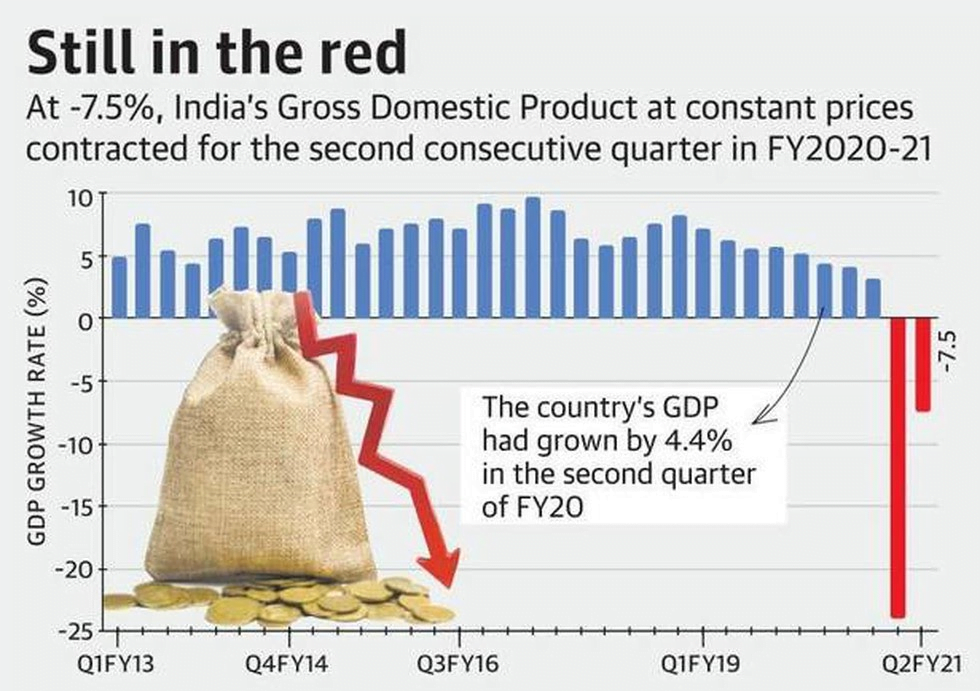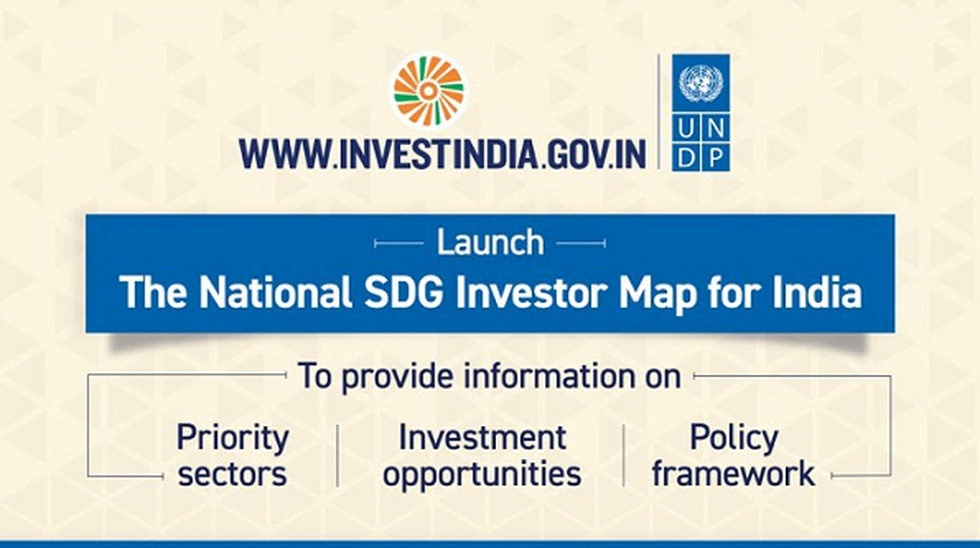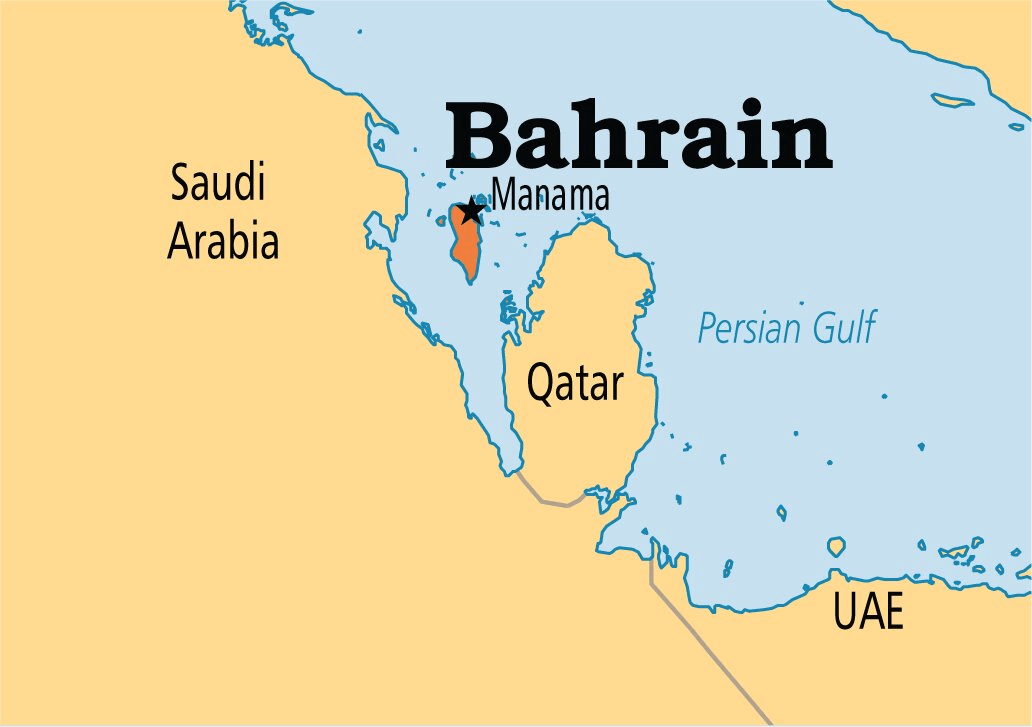IASbaba's Daily Current Affairs Analysis
Archives
(PRELIMS + MAINS FOCUS)
India’s GDP contracts 7.5% in second quarter
Part of: GS Prelims and GS-III – Economy
In news
- As per estimates released by the National Statistical Office, India’s GDP contracted 7.5% in the second quarter of 2020-21.
- In the first quarter, India had recorded 23.9% decline.
Key takeaways
- India has now entered a technical recession with two successive quarters of negative growth.
- Agriculture, which was the only sector to record growth between April and June this year, grew at the same pace of 3.4% in the second quarter.
- Manufacturing gross value-added (GVA) showed a sharp recovery to record 0.6% growth between July and September after collapsing 39.3% in the first quarter.
- Electricity, gas, water supply and other utility services also recorded 4.4% growth in the second quarter, recovering from a 7% contraction in Q1.
- But it remained a weak quarter for several sectors, including mining, services such as retail trade and hotels, construction and financial services.
- While the 7.5% contraction in GDP came as a positive surprise, there are concerns about a decline in government spending and the worsening fate of two key sectors compared to the first quarter.

India Climate Change Knowledge Portal launched
Part of: GS Prelims and GS-III – Environment
In news
- India Climate Change Knowledge Portal was recently launched.
- Launched by: Ministry of Environment, Forest and Climate Change
Key takeaways
- The portal will have all the major steps the Government is taking at both national and international levels to address the climate change issues.
- It will be a single-point information resource that provides information on the different climate initiatives taken by various Ministries enabling users to access updated status on these initiatives.
- According to the Central government, India has practically achieved its pre-2020 climate action targets.
Brain Fingerprinting
Part of: GS Prelims and GS-III – Sci & Tech
In news
- The accused in Hathras rape case will undergo brain fingerprinting.
Key takeaways
- Brain Electrical Oscillation Signature Profiling (BEOSP) is also known as brain fingerprinting.
- It is a neuro psychological method of interrogation in which the accused’s participation in the crime is investigated by studying their brain’s response.
- The BEOSP test is carried out via a process known as electroencephalogram, conducted to study the electrical behaviour of the human brain.
- Under this test, the consent of the accused is first taken and they are then made to wear caps with dozens of electrodes attached to them.
- The accused are then shown visuals or played audio clips related to the crime to check if there is any triggering of neurons in their brains which then generate brainwaves.
- The test results are then studied to determine the participation of the accused in a crime.
Blue Tide phenomenon observed in Maharashtra
Part of: GS Prelims and GS-III – Environment; Science
In news
- Over the last few days, visitors to beaches in Maharashtra have witnessed the fluorescent bluish glow when the waves hit the shoreline.
Key takeaways
- The phenomenon is called ‘blue tide’.
- It appears when luminescent marine life makes the sea appear a deep shade of blue.
- It occurs when phytoplankton (microscopic marine plants), commonly known as dinoflagellates, produce light through chemical reactions in proteins.
- Waves disturb these unicellular microorganisms and make them release blue light.
Do you know?
- Bioluminescence is the property of a living organism to produce and emit light.
- Animals, plants, fungi and bacteria show bioluminescence.
- A remarkable diversity of marine animals and microbes are able to produce their own light.
- It is found in many marine organisms such as bacteria, algae, jellyfish, worms, crustaceans, sea stars, fish and sharks.
- Luminescence is generally higher in deep-living and planktonic organisms than in shallow species.
- It is an anti-predatory response.
- Bioluminescence is assumed to startle predators, causing them to hesitate.
Period Products (Free Provision) (Scotland) Bill
Part of: GS Prelims and GS-II – International Relations
In news
- The Scottish parliament passed a landmark legislation that has made period products such as sanitary pads and tampons free of cost to those people who need them.
- The bill is titled, “Period Products (Free Provision) (Scotland) Bill”.
Key takeaways
- Scotland is the first country to take such a step.
- The bill was passed with the aim of tackling “period poverty”, which is when some people who need period products struggle to afford them.
- Central objective: To end the silence and stigma that surrounds menstruation.
- Aim: (1) To remove gendered barriers; (2) To ensure that those who menstruate have reasonably convenient access to period products free of charge.
Do you know?
What is ‘period poverty’?
- Certain circumstances make access to sanitary products difficult for women and trans people.
- These include homelessness, coercive, controlling and violent relationships and health conditions such as endometriosis.
SDGs Investor Map For India launched
Part of: GS Prelims and GS-II – International Relations
In news
- United Nations Development Programme (UNDP) and Invest India have launched the Sustainable Development Goals (SDGs) Investor Map for India.

Key takeaways
- It laid out 18 Investment Opportunities Areas (IOAs) in six critical SDG enabling sectors, that can help the country push forward on the trajectory of Sustainable Development.
- The six focus sectors: Education, healthcare, agriculture and allied activities, financial services, renewable energy and alternatives and sustainable environment.
- Of the 18 IOAs identified, 10 are already mature investable areas that have seen robust Private Equity and Venture Capital activity.
- The remaining eight IOAs are emerging opportunities, which have seen traction from early-stage investors.
- The map has also identified eight ‘white spaces’, which have seen investor interest and have the potential to grow into IOAs in five to six years with policy support and private sector participation.
Do you know?
- Invest India is the national investment promotion agency under the Commerce & Industry Ministry.
Agreements Between India-Bahrain
Part of: GS Prelims and GS-II – International Relations
In news
- Recently, India and Bahrain have agreed to further strengthen their ties, including in areas of defence and maritime security.
Key takeaways
- The bilateral issues, and regional and global matters of mutual interest, included areas of defence and maritime security, space technology, trade and investment, infrastructure, IT, FinTech, health, hydrocarbon and renewable energy.
- Both countries affirmed to further strengthen their Covid-19 related cooperation.
- Bahrain appreciated the assistance provided by India during the pandemic through the supply of medicines, medical equipment and medical professionals.
- They expressed satisfaction on the operationalisation of the Air Bubble arrangement between the two countries.
- India renewed invitation to Bahrain for visiting India for the 3rd India-Bahrain High Joint Commission meeting to be held in the upcoming months.
Do you know?
- Air bubbles (travel corridors or travel bubbles) are systems established between two countries that perceive each other to be safe and allow carriers of both the countries to fly passengers either way without any restrictions.

(Mains Focus)
HEALTH/ GOVERNANCE
Topic: General Studies 1, 2:
- Issues relating to poverty and hunger.
- Mechanisms, laws, institutions and Bodies constituted for the protection and betterment of these vulnerable sections.
Stepping out of the shadow of India’s malnutrition
Context: Two recent reports — the annual report on “The State of Food Security and Nutrition in the World 2020” by FAO and the 2020 Hunger report, “Better Nutrition, Better Tomorrow” by the Bread for the World Institute – document staggering facts about Indian food insecurity and malnutrition.
The Prevalence of Undernourishment (PoU)
- The PoU measures the percentage of people who are consuming insufficient calories than their required minimum dietary energy requirement.
- In India, malnutrition has not declined as much as the decline has occurred in terms of poverty.
- In terms of percentages, the PoU has declined 24.7% between 2001 and 2018 for India; whereas that for China (76.4%), Nepal (74%), Pakistan (42%), Afghanistan (37.4%) and Bangladesh (18.9%).
- It must be noted that the decline in China is way higher than that of India, even though it had started with lower levels of PoU in 2000.
- In contrast, Afghanistan (47.8%) that started with a higher base than India (18.6%) had experienced higher rates of decline.
- Of note is the fact that, economically, while Afghanistan is relatively much poorer and has gone through several prolonged conflicts in last two decades, it has been more successful in reducing malnutrition than India.
- Therefore, irrespective of the base level of PoU, most of these countries have done better than India on this dimension.
Prevalence of Moderate or Severe Food Insecurity (PMSFI)
- These findings also get substantiated through Food Insecurity Experience Scale survey, which covers almost 90% of the world’s population.
- Because it is not allowed to be conducted in India, direct estimates are not available.
- However, estimates indicate that between 2014-16, about 29.1% of the total population in India was food insecure, which rose up to 32.9% in 2017-19.
- In terms of absolute number, about 375 million of the total population was moderately or severely food insecure in 2014, which went to about 450 million in 2019.
Why National Food Security Act – 2013 failed to tackle malnutrition?
Despite the act ensuring every citizen “access to adequate quantity of quality food at affordable prices”, two crucial elements that still got left out which were
- The non-inclusion of nutritious food items such as pulses
- Exclusion of potential beneficiaries.
Dangers in coming days
- The problem of malnutrition is likely to deepen in the coming years with rising unemployment and the deep economic slump.
- The current COVID-19 pandemic would make the situation worse in general, more so for vulnerable groups.
Way Ahead
- A major shift in policy has to encompass the immediate universalisation of the Public Distribution System which should definitely not be temporary in nature
- There has to be distribution of quality food items and innovative interventions such as the setting up of community kitchens among other things.
- The need of the hour remains the right utilisation and expansion of existing programmes to ensure that we arrest at least some part of this burgeoning malnutrition in the country.
Connecting the dots:
POLITY/ GOVERNANCE
Topic: General Studies 2:
- Structure, organization and functioning of the executive
- Government policies and interventions for development in various sectors and issues arising out of their design and implementation.
Charting a reformed future for the police
Context: Director General of Police (DGP) conference scheduled for early December.
Conference through the years
- Foundation of Conference: Addressing the first in Independent India on January 12, 1950, Sardar Patel, the then deputy PM & home minister, expressed hope that the provincial police would handle law and order on their own, and not depend on the military as an aid to civil power. He also expected better results in criminal investigation with greater coordination between the states
- Impact of Conferences: The recommendations of the annual conference, in the early years, led to a great boost to police infrastructure, induction of human resources and technological upgradation.
- Concern during 1950s to 1970s: Communal violence, crimes against women, vehicle-theft and a range of other issues reflected the concerns of the prevailing times.
- Concern during 1950s to 1970s: Terrorism in Punjab and the insurgency in Jammu and Kashmir became dominant themes in the 1980s and 90s.
- Concerns of 21st Century: Modernisation of Police, Cyber Crimes, Money laundering, infodemics, mob lynching and hate crimes are new challenges that are being faced by Police of today’s times.
However, important pronouncements by home ministers, during conferences in the past, have been largely ignored
- Police Commissionerate System
- In 1962, Lal Bahadur Shastri called for the introduction of the police commissioner system in cities with more than 500,000 people.
- He felt that to handle crimes and law and order, the police should have all powers, even if it meant withdrawing some from the deputy commissioner, revenue.
- Today, more than half of the one-million-plus towns are still without the police commissioner system.
- Organisational Changes in Police System
- In 1964, the idea of an All India Police Commission was strongly mooted
- In 1981, home minister Giani Zail Singh stressed on the need to post an Indian Police Service (IPS) officer as the home secretary or joint secretary in view of the specialised demands of the ministry. The home ministry shelved the proposal.
- Further, recommendations of Commissions under Dharamvira (1977), Ribeiro (1998), Padmanabhaiya (2000), Malimath (2000) lie buried as archival material.
- The home ministry does not brief police chiefs on their status and the public, too, is unaware.
- In 2005, Prime Minister (PM) Manmohan Singh announced a police mission and, in 2014, PM Narendra Modi called for a SMART Police. Both are still works-in-progress
- Key issues have escaped the attention of DGP conferences
- Police reforms, the police commissioner system, police autonomy, management of police cadre and the role of the home ministry are surprisingly never discussed
- The reason cited for not discussing these issues is that police is a state subject.
- Ineffective Prosecution
- Ineffective prosecution is the bane of the criminal justice system.
- While prosecution-guided investigation exists in other countries, there is no coordination between the two in India.
Way Ahead
- Postings at ground level: If police stations are to deliver, then posting of SHOs has to be done by superintendents of police and not on secretarial files.
- Autonomy to DGP: The police should be declared a professional organisation where the CEO, here, the director-general of police (DGP), has unfettered right over transfers of his field commanders and is held accountable for his actions.
- Transparency in Conference: The public airing of DGPs’ resolutions would enlighten citizens and exert moral pressure on chief ministers (CMs) to implement them.
- Agenda of 2020 Conference: Some critical events drawing nationwide attention to the role and functioning of the police must figure on the agenda of conference this year such as the anti-Citizenship (Amendment) Act agitations, Delhi riots, the Vikas Dubey encounter, the Hathras incident, the deaths in Tuticorin police station and the Sushant Singh Rajput case. DGPs must discuss and assess handling of agitations and riots this year, while suggesting a road map for the future.
- Lack of critical forensic support at police stations has to be taken up.
- Sparing use of Discretionary Powers: It is time for the DGPs to decide that sedition laws, defamation and Unlawful Activities (Prevention) Act or National Security Act, are resorted to only in exceptional cases
- Avoid Politicization of Police: Finally, police leaders should resolve not to cede space to the political leadership or bureaucracy on professional matters and cooperate with each other, adhering to the spirit of the law of land
Conclusion
In a democracy, the police is the cornerstone for good governance and should not be taken for granted.
Connecting the dots:
- Long History of attempted Police reforms: Click here
- Police reform and the crucial judicial actor
(TEST YOUR KNOWLEDGE)
Model questions: (You can now post your answers in comment section)
Note:
- Correct answers of today’s questions will be provided in next day’s DNA section. Kindly refer to it and update your answers.
- Comments Up-voted by IASbaba are also the “correct answers”.
Q.1 Consider the following statements regarding India Climate Change Knowledge Portal recently launched by India:
- It will have all the major steps taken by the government at national levels.
- It will provide information on the climate initiatives taken by Ministry of Environment, Forests and Climate Change only.
Which of the above is/are correct?
- 1 only
- 2 only
- Both 1 and 2
- Neither 1 nor 2
Q.2 Which of the following is not correct regarding Brain Fingerprinting?
- The accused’s participation in the crime is investigated by studying his brain’s response.
- The test is carried out through a process known as electroencephalogram.
- The consent of the accused is not required.
- The accused is shown visuals or audio clips related to the crime to study the triggering of neurons that occurs in his brain.
Q.3 Consider the following statements regarding bioluminescence:
- Only fungi and bacteria show bioluminescence.
- It is generally higher in shallow species than in the deep-living organisms.
- It is an anti-predatory response.
Which of the above is/are correct?
- 1 and 2 only
- 2 only
- 3 only
- 2 and 3 only
ANSWERS FOR 27th November 2020 TEST YOUR KNOWLEDGE (TYK)
| 1 | B |
| 2 | C |
Must Read
About India’s apps blocking spree:
About COVID-19 Vaccine race:
About QUAD:














